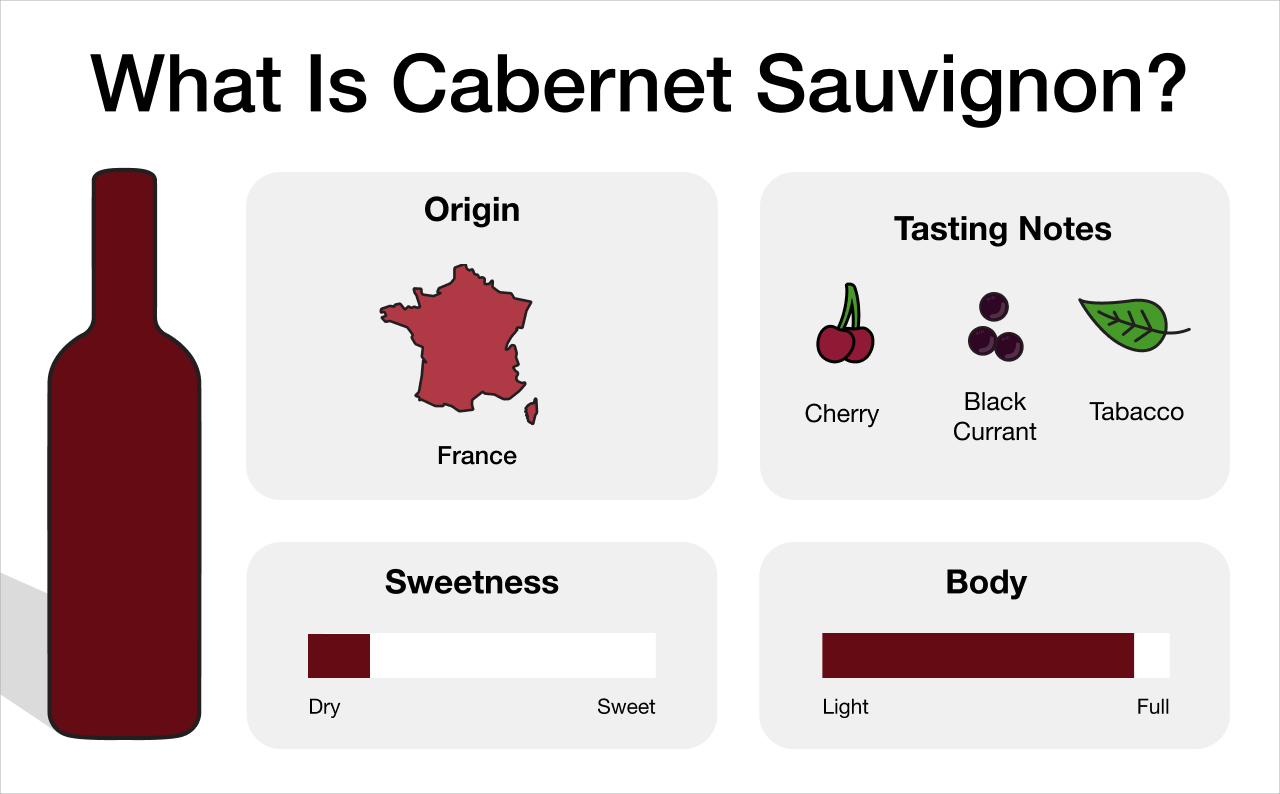
What is Cabernet Sauvignon?
The most popular red wine in the world, Cabernet Sauvignon is a favorite amongst enthusiasts with its bold tannins, jammy fragrance, and ability to pair with various meaty dishes.
There’s a lot to learn about this unique varietal, like why it became so popular, where it came from, and what makes it unique.
Keep reading for everything on Cabernet Sauvignon.
History of Cabernet Sauvignon Wine
Unlike other varietals, Cabernet Sauvignon is actually a relatively new wine. While most wines date back to the Romans, this grape first appeared in the 17th century as a cross between Cabernet Franc and Sauvignon Blanc, which is an extremely rare combination. This wasn’t discovered until 1996 when Dr. Carole Meredith and her team at UC Davis found the true origins of Cabernet Sauvignon.
Throughout the 18th century, the wine gained popularity for its prominence in Bordeaux blends and soon spread across Europe. The tough, thick skins of Cabernet Sauvignon grapes and their ability to withstand harsh climates made them well sought after by winemakers.
France was known for its Cabernet Sauvignon until 1976 when French wine critics came together and held a blind taste test. Top Bordeaux wines from Cru Classé were compared to California Cab Sav.
In the blind taste test, the California Cabernet won, proving that great wines aren’t just made in France. This event was later known as “The Judgement of Paris.” Soon after, Cabernet Sauvignon’s popularity skyrocketed around the world.

Cabernet Sauvignon Taste
Cabernet Sauvignon is a bold, full-bodied red wine with a higher alcohol content, medium acidity, and potent tannins (which cause the astringent taste on the palate), and jammy, dark berry notes. Specific flavors include blackcurrant, black cherry, spice, tobacco, wood, black pepper, and vanilla.
Cabernet grapes are strongly influenced by their harvest, which greatly affects the taste. When made from fully ripened grapes, Cabernet wine stands on the fruitier side. When less ripe, the grapes are high in organic compounds known as pyrazines, responsible for the wine’s distinct green bell pepper note.
Some wine drinkers will seek out this Cabernet characteristic as green bell pepper is a notably unique trait distinct to the variety.

Is Cabernet Sauvignon Sweet or Dry?
Now that we’ve addressed this wine’s flavor profile, it’s time to answer the question, “Is Cabernet Sauvignon dry or sweet?”
During winemaking, most of the residual sugars are converted into alcohol, making it a dry red wine. Due to its high tannin content, this wine is also excellent for long-term oak aging, usually taking about a year or more.
While most red wines may have their grape flavors diluted too much during the process, Cabernet Sauvignon becomes much more mellow while maintaining its bold, fruity flavors.
Cabernet Sauvignon is unmistakably one of the more dry wines.
Pinot Noir vs Cabernet Sauvignon vs Merlot
As one of the most popular red wines, Cabernet Sauvignon is often compared to Pinot Noir and Merlot, which bear similar fruity profiles. However, there are subtle differences between these wines that are easy to spot once you know how to recognize them.
Merlot is a medium-bodied red wine that emits plum, blackberry, cherry, and red fruit notes. It has lower tannins than Cabernet Sauvignon, causing it to taste silkier and maybe even sweeter (though it actually isn’t).
Pinot Noir is a much lighter and thinner wine than the two, with bright raspberry, cherry, floral, and even mushroom notes. Its low tannins and light body make it an easy sipper.

Cabernet Sauvignon Food Pairings
Cabernet Sauvignon is one of those wines better enjoyed when paired with a hearty dish. Because of its high tannins and robust nature, seek out meals with more protein and fat. The tannins act as palate cleansers when eating fatty red meats like ribeye steak, while the fat and protein of the cut smooth the tannins of the wine, making it less intense when sipping.
Prime rib, filet mignon, and New York strip steak are all exquisite pairings for Cabernet Sauvignon. You can also add a rich reduction sauce or balsamic glaze to the meat to further balance the acidity of the wine.
Avoid starchy dishes like plain pasta and rice, as these foods aren’t strong enough to stand up against the rich tannins of a superb Cabernet.
Where to Find Great Cabernet Sauvignon
With its global appeal and ability to grow in a variety of climates, you don’t want to miss the bold, fruity taste of Cabernet Sauvignon.
Shop premium Cabernet Sauvignon from around the world at Macy’s Wine Shop for incredible prices.
See The Wine Blog for all your wine needs.









